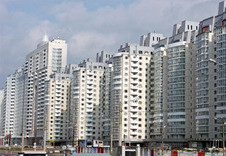 Insulation of the apartmentAnd if the apartments are in new buildingsWhile they still retain heat well (although not always), apartments in old houses are often very cold. Plus, the heating system of many old houses is worn out and functions with great difficulty. In winter, such apartments turn into a small branch of the North Pole. However, you can try to insulate the apartment yourself. I will say right away that effectively insulating an apartment only from the inside is not a very simple task, since proper thermal insulation of a house is a complex event affecting the facade. But facade work is beyond the capabilities of residents of apartment buildings, so we will focus on internal insulation. The first and most important part of insulating an apartment is the windows and doors of loggias and balconies. If possible, it is better to replace the old wooden "Soviet" windows with modern double-glazed windows, preferably double-glazed. If this is not possible, then repair the old windows. First, you need to go around the perimeter of the glass; second, put rubber seals on the window frames. Replacing old heating radiators with new, more efficient ones also helps. But often replacing windows and radiators is still not enough. In this case, wall insulation is required. First, let's list the main materials used for wall insulation:
Insulation of the apartmentAnd if the apartments are in new buildingsWhile they still retain heat well (although not always), apartments in old houses are often very cold. Plus, the heating system of many old houses is worn out and functions with great difficulty. In winter, such apartments turn into a small branch of the North Pole. However, you can try to insulate the apartment yourself. I will say right away that effectively insulating an apartment only from the inside is not a very simple task, since proper thermal insulation of a house is a complex event affecting the facade. But facade work is beyond the capabilities of residents of apartment buildings, so we will focus on internal insulation. The first and most important part of insulating an apartment is the windows and doors of loggias and balconies. If possible, it is better to replace the old wooden "Soviet" windows with modern double-glazed windows, preferably double-glazed. If this is not possible, then repair the old windows. First, you need to go around the perimeter of the glass; second, put rubber seals on the window frames. Replacing old heating radiators with new, more efficient ones also helps. But often replacing windows and radiators is still not enough. In this case, wall insulation is required. First, let's list the main materials used for wall insulation:
All of the listed materials have low thermal conductivity and perform their main task - thermal insulation of the room - well.
Mineral wool and glass wool
This is the cheapest material ofof the above, absolutely non-flammable. Mineral wool is thin and flexible fibers obtained by cooling a mineral melt previously crushed into drops and drawn into threads. The disadvantages of mineral wool include an increase in thermal conductivity when wet and, accordingly, the need for vapor barrier, as well as shrinkage over time. There is a myth associated with mineral and glass wool that it is "harmful to health". This is not true. Dust generated when working with these materials is harmful to health. Therefore, workers use respirators when working with mineral and glass wool. But after it is laid, covered with a vapor barrier film and plasterboard, it is absolutely harmless.
Foams and foamed polyethylene
These are just foamed plastics and polyethylenes.They are not afraid of high humidity, in addition, they are very easy to install, they can be glued to the main wall. Among the disadvantages, it is possible to highlight the fact that this material belongs to the class of flammable, although to "low-flammable and self-extinguishing". When buying this group of insulation, you should pay attention to the presence of fire-resistant additives in the material.









